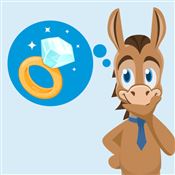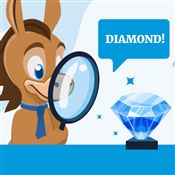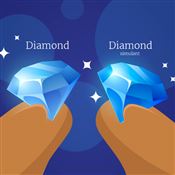History of Diamond Engagement Rings
The tradition of a diamond engagement ring is modern. Learn how and when it was invented.
 |
| © CreditDonkey |
80 years ago, only 10% of American women received diamond engagement rings.
Nowadays, most men buy a diamond ring to show their love. A lot of saving up and learning about how to buy the perfect diamond goes into the process.
But why does it happen?
What made diamond rings so popular?
Origin of Engagement Ring
 |
Around the 1940s, De Beers launched a brilliant ad campaign that equated a diamond with love. This gave birth to the modern diamond engagement ring phenomenon.
Here's how the diamond engagement ring came to be.
The First Engagements
Engagements weren't always as glamorous as they are today.
The tradition of exchanging wedding rings goes back 4,800 years to ancient Egypt. But back then, the rings were made of stuff like braided papyrus and reeds. The endless circle was a symbol of eternity and the hole was a symbol of a doorway to the future. This simple exchange was a symbol of true love.
They believed the 4th finger had a vein that led straight to the heart. It's the main reason why our 4th fingers are known as the "ring finger."
Later on, the Romans followed this tradition. They were the first to exchange jewelry. But the meaning got skewed along the way. Instead of a symbol of love, the ring became more of a claim of ownership.
- The Romans originally started with the exchange of iron rings. This was their sign of devotion to one another.
- Some Romans did provide their loved ones with gold rings. They were only to be worn on special occasions outside the home, though. The iron rings continued to be worn at home.
- The engagement ring was a sign of a contract between two people. It was a promise to wed. It also transferred the ownership of the daughter from the father to the new husband.
Many of our traditions are similar to the Romans'. Men still ask for permission from the father of the (soon-to-be) bride. While not the same as "transferring ownership," the sentiment is the same.
The first diamond engagement ring ever used was in 1477, when Archduke Maximilian of Austria asked Mary of Burgundy to marry him. The diamonds were in the shape of an "M" and were very thin and delicate. Back then, diamonds were expensive even for European aristocrats.
Archduke Maximilian got in over his head in debt. At the end of his reign, he owed 10 years' worth of income in debt.
Diamond Ring Popularity
Diamonds were once very scarce and expensive.
Then in 1870, huge diamond resources were discovered in South Africa. Diamonds were no longer a rarity. Everyone could own a diamond if they wanted.
The British businessmen that operated the mines had a clever idea. They maintained the illusion that diamonds were scarce. This meant they could drive up diamond prices.
- The businessmen created the first diamond cartel. It was called De Beers Consolidated Mines, Inc. The cartel was in full control of the diamond supply. They also controlled the prices.
- It only took them 10 years to control 90% of the world's diamond supply.
- The cartel managed to influence diamond demand as well.
De Beers is still a large influence in the diamond industry today.
Diamonds Are Forever Slogan
With De Beers in possession of vast resources of diamonds, they needed to find a way to sell them. They had to drive up demand.
They launched a massive advertising campaign.
The campaign marketed the idea that diamonds are a sign of your devotion. It also made diamonds the ultimate status symbol. De Beers, along with ad agency N.W. Ayers, made men believe:
- Diamonds were the only way to show your love to a woman.
- A woman measured a man's love based on the diamond size.
- Anyone who was anyone in life must have a diamond on their finger, just like the celebrities.
Around 1940 they came up with the slogan "Diamonds Are Forever." This slogan got people to associate diamonds with everlasting commitment and love.
De Beers played on the fact that celebrities got diamond rings as well. They wanted women to want the diamonds. And, ultimately encourage men to buy them.
De Beers helped outfit more than half of the married women in Japan. Nowadays, Japan and the United States are the largest diamond engagement ring markets.
Diamond Rings as Insurance
Around the same time in the 1940s, the U.S. started doing away with the "Breach of Promise to Marry" law. This also caused more women to ask for a diamond ring.
The law allowed women to sue a fiancé who broke off the wedding. Here are some facts about social rules back then:
- Women were expected to remain pure for their men. However, many couples still were intimate before tying the knot. If the man were to break off the wedding, the woman would be seen as tainted. And undesirable to future potential suitors.
- Most women also didn't work. The loss of an engagement would also leave her financially stranded.
- Engagements were still mostly just verbal promises. This law was created to protect the woman if it was broken off.
Once the Breach of Promise law started dissipating, a verbal promise just wasn't good enough anymore. Now, women needed some other form of insurance.
It just so happens that De Beers launched their massive diamond campaign. A diamond ring made the perfect insurance. Men spent a good deal of money buying it, so it's less likely he'd just break off the engagement. And if he did, she would still have something to make up for it.
Traditions Before Diamond Engagement Rings
The Romans gave iron or gold rings during a proposal. Other cultures had other unique ways. Here are a few examples:
- English couples were considered to be engaged after breaking a piece of metal together (either gold or silver). After this, they would drink a glass of wine together. They were then considered engaged.
- Early in American history, men gave women thimbles as a sign of their devotion. After the wedding, the women would cut the thimble into a ring shape and wear it.
These examples show the similarities of proposals. Even though diamonds weren't exchanged, the idea is the same. There is intent to marry. The object serves as commitment to fulfill the promise.
The Engagement Ring Today
Today, the engagement ring is more of a symbol of love and commitment.
- It's the promise of marriage from a man to a woman.
- It shows the man is serious enough about the relationship to save up for the ring.
- It shows others that a woman is no longer available.
Today, women have their own careers. And there's no negative stigma about pre-marital sex. So, engagement rings are less about insurance now. They're a symbol of love.
Broken Engagements
Luckily, the days of holding a ring as collateral are behind us. Today, broken engagements can be handled in several ways:
- If the ring was a gift, the woman can keep the ring. If a court of law becomes involved, it must be proved it was meant as a gift. And that the woman accepted the ring as a gift.
Tip: It's recommended to not propose on Christmas, Valentine's Day, or their birthday. Not only for devoting a day to the engagement, but the ring can't be considered a gift.
- Some courts view the engagement ring as a conditional gift. The man gives the woman the ring on the premise that she will marry him. If the marriage doesn't happen, the condition doesn't exist. This means the gift doesn't exist. The court awards the ring to the man.
- Sometimes couples think of the ring as compensation for a broken engagement. This usually occurs when there's money involved. Women who help men get ahead financially often feel this way. If a man breaks off the engagement, the woman uses the ring as compensation for her investment.
Of course, these are just examples of what may happen. Every couple handles their engagement and break-up differently.
The Decline in the Diamond Engagement Ring
According to IDEX, the attachment to diamond rings as engagement rings is slowly declining. 75% of American women used to receive a diamond engagement ring. Today, that rate is slowly falling. There are several reasons for it, including:
- Women are getting married later. The average age used to be around 20½ years old. Today, it's more like 26.2 years old.
- More women just aren't getting married. 50% of 25- to 29-year-olds remain unmarried today.
- Women choose less expensive options or opt for a family heirloom.
Diamonds are forever, but what if you don't like your ring? 57% of women don't like their rings. They don't mind wearing it, but it's not what they would pick.
Bottom Line
The "tradition" of a diamond engagement ring is all down to an ad campaign. Along with the woman's need for insurance, the diamond ring's popularity soared.
Today, it is seen more as a symbol of love and commitment. The idea that "A Diamond Is Forever" will likely always remain.
Write to Kim P at feedback@creditdonkey.com. Follow us on Twitter and Facebook for our latest posts.
|
|
|









